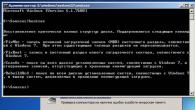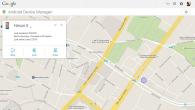2. After making sure that everything you need has already been transferred to the external drive, go to the App Store and download the OS X Yosemite image.

This step will have to be completed in mandatory, because for a clean install your account must first be upgraded to OS X Yosemite. Only in this case will the Mac prompt you to reinstall OS X Yosemite (and not OS X Mavericks if you skipped an update from the App Store).

without updating through the App Store, you will be offered OS X Mavericks as a “clean system.”
So you first update the existing OS X Mavericks to OS X Yosemite through the App Store, and then perform a clean installation of the system.
After updating to OS X Yosemite via the App Store and successfully logging in, reboot.
3. As soon as a white screen appears in front of your eyes and the Mac makes the characteristic sound of starting to boot, hold down the key combination Command+R. We wait patiently for the loading lane to pass.

4. We are greeted by a window OS X Utilities. Choose Disk Utility and press Continue.

5. Choose Primary disk on which the system was installed, give it a name and select Erase. After a few seconds you will see a completely blank disk.

6. Close disk utility and go to point Reinstall OS X(in the OS X Utilities menu). Select the newly formatted disk as the target disk for installation. The installation will begin immediately.

When reinstalling the system from scratch, keep in mind that you must know your account password, used in Mac App Store. Otherwise, installation will not be possible.
7. Pay attention to the status WiFi connections(upper right corner) – Internet access is required, since the system will be loaded from Apple servers. Otherwise, you risk getting an error.

Depending on the load on the servers at a particular time, installation may take from 20-30 minutes before several hours. If you have the ability to connect using a power cord "twisted pair"– this can significantly speed up loading.
After rebooting, you will be greeted by the new OS X Yosemite start screen and asked to go through the usual “first login” steps.

Good luck installing and testing the new OS X Yosemite.
Quite often, Mac users are faced with the following problem - how to return the computer to factory settings, resetting all user information, and reinstall the operating system “cleanly”. Instructions for this process are presented below.
The Mac, like most other Apple devices, is intended for personal use. This means that usually computer owners fine-tune the system for themselves and another user will not be entirely comfortable working with it. If there is a need to completely get rid of existing data and settings, then you need to follow the simple steps described below.
Clean installation of macOS: preliminary steps
IMPORTANT: Before a clean installation (reinstallation, flashing, factory reset) of a Mac, be sure to check:
- Is the Mac tied specifically to yours and not to any other
- Do you remember the credentials (username and password) of your Apple ID. You can check, for example, by logging into this page (from your computer).
The fact is that if the function was activated on the Mac (located along the path: System Settings → iCloud → ), then after reinstalling the system (resetting to factory settings), the system will ask you to enter the Apple ID to which the device is linked.

ON THIS TOPIC:
How to reset Macbook, iMac, Mac mini, Mac Pro to factory settings (how to reinstall macOS)
Boot Mac into Recovery Mode
1. Make sure you have an Internet connection (for later installation of macOS), as well as an electrical connection in the case of a MacBook.
Attention! Further actions will lead to the complete deletion of ALL data on the Mac - save the necessary information on external media in advance;
2. Restart your computer (or turn it on if it was turned off) using the menu → Reboot;
3. During the reboot process, press and hold the key combination that suits you best:
⌘Cmd + R– installing the version of macOS that was running on the computer before problems arose. Those. your Mac will install exactly the same version as before.
⌥Option (Alt) + ⌘Cmd + R– Update to the latest version of macOS that your Mac is compatible with. For example, if the Mac was running High Sierra, and the breakdown occurred after the final build of macOS Mojave was released, the system will download Mojave from the Internet and install it.
⇧Shift + ⌥Option (Alt) + ⌘Cmd + R– installation of the version of macOS that was originally installed on the computer (or the closest available version to it).
Note: macOS Sierra 10.12.4 or newer required.
4 . Then the window “ macOS Utilities"(on versions below macOS High Sierra may be called "macOS Utilities"). Here you need to select " Disk Utility" and click " Continue";

1 . Select in Disk Utility your drive in the menu on the left (usually a Macintosh HD, it's at the very top).
2 . Click on the inscription First aid.
3 . Click Launch. The application will check the boot disk for “health status”, i.e. functionality and correct existing errors. This process may take some time.

4 . After checking is completed, click Ready.

Erasing the boot disk
1. In the application Disk Utility, select a verified boot disk, go to the section "Erase"(at the top of the screen);

2. On the menu "Format" select APFS (for computers with macOS Sierra installed and an older version of the OS, select Mac OS Extended) and press " Erase";


3.
Once the disk formatting process is complete, click " Complete" to exit Disk Utility.
Reinstalling the macOS operating system (factory reset)
Reinstall macOS using the appropriate item (screenshot below) and follow the instructions. The latest version of macOS will be downloaded from the Internet and the macOS reinstallation process will begin. During this time, the computer may restart.
Note: If you're installing from scratch, you'll have to configure your Mac and program settings all over again.


Macbooks are famous for their stable operation, but this machine is no stranger to software glitches, including critical ones, when the situation can only be corrected by reinstalling the operating system. In this article we will tell you how to reinstall Mac OS.
However, before you rush to reinstall the system, you need to carry out one important procedure - transfer important information to another device, because reinstallation will most likely damage the files on the Macbook.
Reinstallation
Is the information you need saved in a safe place? Great! Then we proceed to reinstall the system. This procedure, let’s say right away, is simple and feasible even for a non-advanced user, the main thing is to strictly follow the instructions. As for time costs, reinstallation will take about an hour.
So let's get started:

Well, you're almost ready - all you have to do is wait for the installer to complete its work and perform the initial setup of the device.
Initial setup
The initial setup menu will load automatically, you will need:

Once these items are configured, you will receive a Macbook with a reinstalled operating system. Please note that some initial setup steps can be skipped; in items that can be ignored there are corresponding buttons, for example, in item 8 you can click “Do not register”.
Let's summarize
Well, now you know how you can reinstall Mac OS on a MacBook, and it’s worth noting that this guide works for both Macbook Air and Macbook Pro. The reinstallation procedure, as we promised, is simple and straightforward; here, unlike Windows, you don’t even need any disks with the operating system - the laptop will download everything itself, the only condition being access to a high-quality Wi-Fi network. We hope everything worked out for you, and if not, contact support or a service center.
The MacOS X operating system is Apple's own development and is installed on all its computers. Thanks to its tight integration and hardware design, it offers high stability and performance. A new version of this OS is released once a year, and during its service life, updates are regularly released to correct detected errors. We will tell you in this article how to reinstall Mac OS X on your computer and what installation options are available.
Terms of distribution
Mac OS X is a proprietary operating system, the first version of which was released in 2001. Over the next twelve years, it was distributed on a paid basis, and all its versions bore “cat” names. The first in this series was OS 10.0 “Cheetah”, the last one was 10.8 “Mountain Lion”.
Starting with version 10.9, MacOS is distributed free of charge, and code names began to be assigned in honor of geographical objects located in the state of California. The first operating system in this series was released in 2013 and was named Mavericks, after a popular Californian beach.
In 2016, Apple changed one of the clauses in its license agreement with users. MacOS has since been considered not purchased, but leased from the company for the duration of use of its equipment. However, this change mostly affects those users who use the so-called MacOS on a third-party computer.
Update from App Store
The easiest way to install a new version is to download it from the App Store. Let's see what needs to be done in this case and how. You can reinstall Mac OS X in this way on any Apple computer whose hardware supports the latest version of the operating system.

To download, you will need a working OS and Internet access. On the App Store home page, in the “Quick Links” section, the very first one will be the current version of Mac OS available for your computer. By going to the operating system page, select the “Download” option, and in the “Programs” folder you will see its image with the name “Install Mac OS”, the current build number and an indicator showing the progress of downloading it from the company’s servers.
After receiving the image on your computer, all you have to do is run it like a regular program. In the future, without your participation, several reboots will take place, and you will be able to use the latest Apple operating system.
Installation from recovery partition
Over time, hardware requirements increase, and even if your laptop officially supports the new version, it can work more efficiently on the old one. Let's look at how to do it on a MacBook without changing the OS to a newer one. In this case, we will also need a connection to the World Wide Web.

At boot time, you must use the keyboard shortcut Command+R. With its help, you get to the recovery menu and choose how to reinstall Mac OS. You will be able to upgrade to the latest supported version or the latest version in use. By choosing the second option, you will actually install back the OS on which your laptop showed better performance.
When using the restore feature, you also have the option to return the version of the operating system with which you purchased your computer. If you choose to perform this operation, you will need to use a more complex key combination during the initial boot phase. While holding down Shift+Command+Option+R and answering the question about how to reinstall Mac OS, select the option to install the system that came with it.
Installation from a flash drive
After new versions of Apple's OS are released, a clean installation may be necessary to activate all available features. In this case, you need to know how to reinstall Mac OS from scratch using a bootable USB flash drive. This option is not much more complicated than the previous ones, and the only thing you need is an external drive of at least 8 GB in size and named Untitled. You can rename it using the Disk Utility program included in the OS.

First, you will need to download the boot image to your computer using the method described above. Once you have received it, you can start creating your own bootable USB flash drive. We will use only the standard tools of the operating system itself and create an installation disk using the Terminal program. Copy the following command into its window:
sudo /Applications/Install\ macOS\ Sierra.app/Contents/Resources/createinstallmedia --volume /Volumes/Untitled --applicationpath /Applications/Install\ macOS\ Sierra.app --nointeraction
To perform this, you will need an administrator account or knowledge of the administrative password. If you have followed our recommendations exactly before, then after no more than half an hour you will have an installation disk with the latest version of OS X Sierra in your hands.
Finally
From this material, you learned how to reinstall Mac OS on your computer and what options are available for completing this task. As you can see, the process of reinstalling the Apple operating system is quite simple and downloading its image will take you the most time. Having coped with this task, you can consider yourself a real poppy grower.
Fair, not overpriced and not underestimated. There should be prices on the Service website. Necessarily! without asterisks, clear and detailed, where technically possible - as accurate and concise as possible.
If spare parts are available, up to 85% of complex repairs can be completed in 1-2 days. Modular repairs require much less time. The website shows the approximate duration of any repair.
Warranty and responsibility
A guarantee must be given for any repairs. Everything is described on the website and in the documents. The guarantee is self-confidence and respect for you. A 3-6 month warranty is good and sufficient. It is needed to check quality and hidden defects that cannot be detected immediately. You see honest and realistic terms (not 3 years), you can be sure that they will help you.
Half the success in Apple repair is the quality and reliability of spare parts, so a good service works directly with suppliers, there are always several reliable channels and your own warehouse with proven spare parts for current models, so you don’t have to waste extra time.
Free diagnostics
This is very important and has already become a rule of good manners for the service center. Diagnostics is the most difficult and important part of the repair, but you don't have to pay a penny for it, even if you don't repair the device based on its results.
Service repairs and delivery
A good service values your time, so it offers free delivery. And for the same reason, repairs are carried out only in the workshop of a service center: they can be done correctly and according to technology only in a prepared place.
Convenient schedule
If the Service works for you, and not for itself, then it is always open! absolutely. The schedule should be convenient to fit in before and after work. Good service works on weekends and holidays. We are waiting for you and working on your devices every day: 9:00 - 21:00
The reputation of professionals consists of several points
Company age and experience
Reliable and experienced service has been known for a long time.
If a company has been on the market for many years and has managed to establish itself as an expert, people turn to it, write about it, and recommend it. We know what we are talking about, since 98% of incoming devices in the service center are restored.
Other service centers trust us and refer complex cases to us.
How many masters in areas
If there are always several engineers waiting for you for each type of equipment, you can be sure:
1. there will be no queue (or it will be minimal) - your device will be taken care of right away.
2. you give your Macbook for repair to an expert in the field of Mac repairs. He knows all the secrets of these devices
Technical literacy
If you ask a question, a specialist should answer it as accurately as possible.
So that you can imagine what exactly you need.
They will try to solve the problem. In most cases, from the description you can understand what happened and how to fix the problem.






